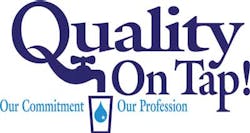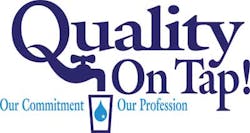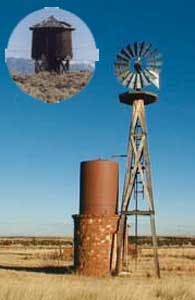Rural Revenue: A Look at Small Water and Wastewater Utility Cost Challenges and Solutions
By Art Haddaway, WaterWorld Editor
Small and rural water and wastewater utilities across the U.S. face a number of unique challenges, some far different compared to those of larger, urban facilities, particularly when it comes to managing capital costs. These smaller systems, which make up a vast majority of the nation's systems, can often lack the necessary funding to meet the industry's growing demands, exacerbated by lower population density, higher poverty levels, and labor and resource shortages.
"By definition, small utilities have fewer resources to meet those challenges," said Matthew Holmes, Deputy CEO of the National Rural Water Association (NRWA). "On one hand, [they] face the same compliance requirements, the same responsibilities for the protection of public health and the environment that large systems do. But on the other hand, small utilities have a smaller customer base, and that means their fixed costs are spread out over fewer people, leading to a lack of economies of scale."
Small plants - those serving 10,000 people or less or those producing 20 million gallons or less of water per day - face the same demands as large facilities, such as aging infrastructure, customer expectations, drought and water scarcity, and federal and state water quality standards and regulations, but frequently collect less revenue. Despite the likelihood that rural utilities will generate limited earnings compared to those of larger systems, there are ways to effectively manage and generate sufficient funds.
According to John Padalino, Rural Utilities Service Administrator for the U.S. Department of Agriculture (USDA), small utilities can prioritize their investments toward improving customer satisfaction, infrastructure and equipment preservation, staff training, and regulation compliance. He indicated that one of the main financial goals of rural plants today is "finding revenue to ensure that systems have the capacity to meet community needs and to respond to growth while keeping rates affordable, comply with environmental regulations, and find and retain technical staff to operate and maintain the systems."
Other important considerations are outlined in the 2013 Rural and Small Systems Guidebook to Sustainable Utility Management, a collaborative manual published jointly by the USDA and the Environmental Protection Agency (EPA) to help small utilities further allocate their expenditures toward the appropriate resources. Further, the guidebook offers these plants a step-by-step self-assessment that, according to Holmes, helps them compile the complex, financially burdensome circumstances they face into more manageable and achievable projects - ultimately with the goal of achieving improved capital management.
Along with customer satisfaction, staff training, and infrastructure stability, the guidebook lists other areas of investment that utilities can target in order to maximize their financial results: product quality; operational resiliency; operational optimization; community sustainability and economic development; water resource adequacy; and stakeholder understanding and support. These components more or less provide a balanced framework for these plants to identify primary deficiencies and integrate solutions that encompass short- and long-term financial stability.
"Many of these are technical challenges," said Holmes, "and that leads into financial specifics, too, because of the way they're funded - the debt capacity that the systems have, the debt load they contain, and the income characteristics of the community - and then you add in different treatment needs, the costs of which can vary substantially."
Padalino added, "If you don't address these issues, down the line you're going to have a system that fails. You're going to have a system that's going to be in need of significant upfront capital to solve an immediate problem like lack of quantity or poor quality water."
"If you don't plan day in and day out for the longer term, it's going to catch up with you sooner or later," he said, "and you're going to have many more financial problems, and you're going to have significant rate hikes that come much faster than what people can afford. If you do it incrementally over time, that's a much better approach."
Padalino outlined four tactics to effective financial management: leveraging financial resources; ensuring sustainable operations and management of systems; partnering with local entities and communities; and incorporating energy-efficient programs. These, he said, are essential to helping mitigate and prevent many of the recurring aforementioned challenges as well as safeguarding the assets of rural water and wastewater systems and the communities they serve. Further, small utilities can target overall performance improvement and realize a holistic, well-run system.
Financial experts maintain that leveraging certain resources can be beneficial to utilities as a means of establishing a balanced financial structure, especially when it comes to determining rates. Padalino remarked, "We have to think about leveraging resources between the different federal financing entities, between state and local financing entities, and even looking for other philanthropic entities that want to do social impact investing, especially with small systems, to be more innovative in how they manage."
In a recent article, the Metropolitan Planning Council (MPC) serving the Chicago, Ill., area suggested that facilities consider implementing full-cost pricing, which utilizes a two-pronged rate structure consisting of both a fixed and variable charge. This can be particularly beneficial for utilities and customers alike amidst smaller population density and higher poverty rates throughout certain rural regions of the country. The blog noted that "this pricing scheme allows utilities to have their fixed costs covered even if demand decreases due to higher prices."
Partnering with other local entities is also important. Not only can utilities collaborate to identify problems and share solutions, they can ensure a reputable network of needed staff. According to Holmes, many of these rural operation specialists, some of whom are volunteers, "have to perform most, if not all the technical functions in rural systems and may also be managers and bookkeepers as well." Padalino suggested there are things utilities can do in partnership with other smaller systems through inter-local agreements to share the costs of chemicals, for example. "By working together, they can share an operator perhaps, or they can share the costs of the contractors that help them maintain and operate their systems."
Focusing on energy efficiency can also be advantageous to rural utilities striving to enhance their profits. It's estimated that one of the largest expenses for both large and small facilities is their power bill, and concentrating on certain conservation efforts, such as variable-frequency drives, demand side management, etc., and working with the electric utility can significantly lower these costs. "Energy is a big issue for treatment plants," said Padalino. "Typically within an electric-service provider's territory, they're one of the largest loads in the system, so we can do a lot of good by focusing on energy efficiency at a water system."
"Rural America is vital to the economy and security of the nation, and we have no other choice but to ensure the sustainability of rural water systems if we wish to retain the character and heart of America," said Holmes. "Rural communities drive tourism and provide food and natural resources, so it's a vital issue to provide this basic infrastructure - prioritizing funding and assistance for communities in need - if we're going to retain our quality of life."
About the Author

Art Haddaway
Assistant Editor
Art Haddaway is the Assistant Editor of WaterWorld and Industrial WaterWorld magazines. A writer and editor of over 10 years, he has contributed to a variety of regional publications covering everything from current events to creative features. Art is a graduate of Oral Roberts University in Tulsa, Okla., with a bachelor’s degree in print journalism.


